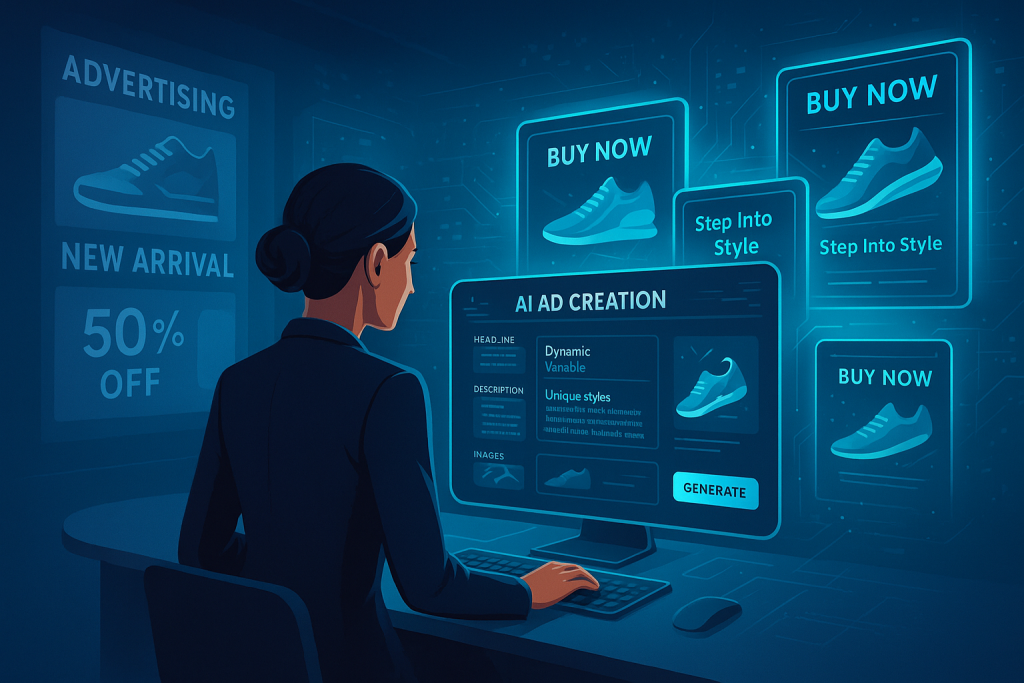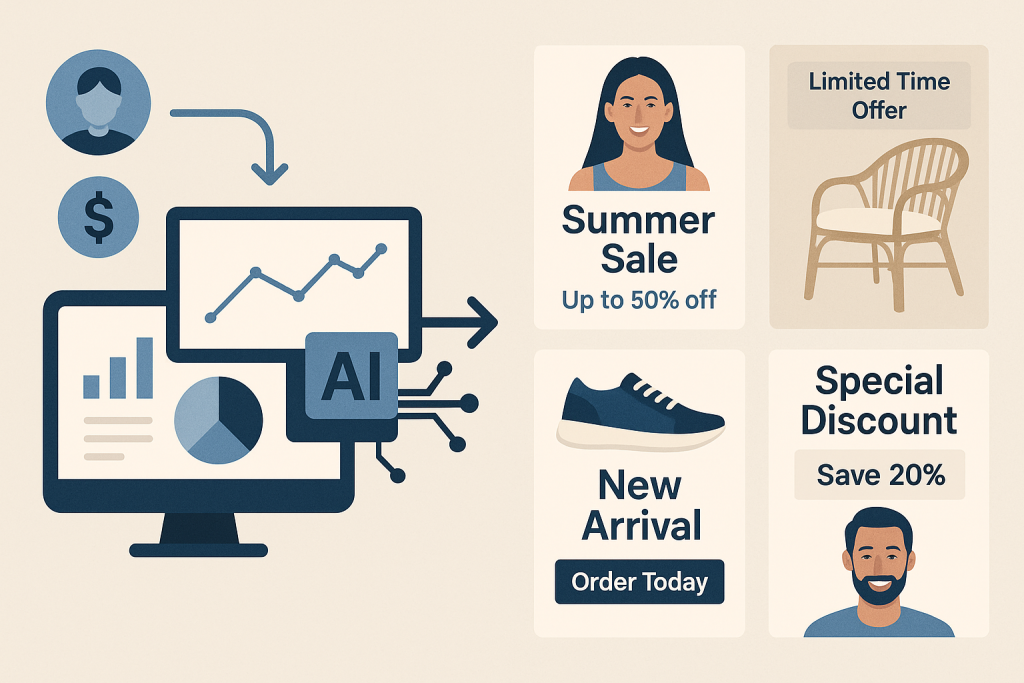Revolutionize Campaigns with AI-Powered Ad Creation Suites
In today’s fast-paced digital marketing landscape, staying competitive means embracing innovation at every turn. One of the most transformative developments in recent years has been the rise of AI-driven ad creation suites – powerful tools that are fundamentally changing how brands conceptualize, create, and optimize their advertising campaigns.
These sophisticated platforms are helping marketers overcome long-standing challenges of scale, personalization, and performance optimization. But what exactly makes these tools so revolutionary, and how can your organization leverage them to gain a competitive edge?

The Evolution of Ad Creation Technology
The journey from traditional advertising to today’s AI-powered solutions represents one of the most significant transformations in marketing history. Understanding this evolution provides valuable context for appreciating the capabilities we now take for granted.
From Static to Dynamic: The Ad Creative Revolution
Not so long ago, creating advertisements was an entirely manual process. Designers, copywriters, and marketing teams would laboriously craft each ad, often taking weeks to move from concept to publication. This approach came with significant limitations:
- Time-intensive production that couldn’t keep pace with market demands
- Limited customization across audience segments
- Difficulty scaling for multiple platforms and formats
- Minimal opportunity for testing due to production constraints
The introduction of template-based systems in the early 2000s represented the first significant step toward automation. These systems allowed for some standardization and faster production but still relied heavily on manual input and offered limited flexibility.
The real breakthrough came with dynamic creative optimization (DCO), which allowed for rule-based customization of ad elements based on user data. This technology laid the groundwork for what would become today’s AI-driven solutions, which leverage sophisticated templates and dynamic elements to create highly personalized experiences.
Core Technologies Powering Modern Ad Creation Suites
Today’s advanced AI ad creation platforms rely on several sophisticated technologies working in concert:
| Technology | Function in Ad Creation | Impact on Results |
|---|---|---|
| Machine Learning Algorithms | Pattern recognition and predictive modeling for ad performance | Continuously improving optimization based on real-world results |
| Natural Language Processing | Understanding context and generating compelling ad copy | More relevant, persuasive text that resonates with target audiences |
| Computer Vision | Image analysis and generation for visual ad components | Higher-quality, more engaging visual elements optimized for each platform |
| Predictive Analytics | Forecasting performance and identifying optimization opportunities | Improved ROI through data-driven decision making before deployment |
These technologies don’t operate in isolation – they form an interconnected ecosystem that continuously learns and improves, making each campaign more effective than the last.
Key Components of AI-Driven Ad Creation Platforms
Modern AI ad creation suites combine multiple powerful capabilities that work together to transform the advertising workflow. Understanding these components helps marketers identify the right solutions for their specific needs.
Smart Ad Builders and Visual Generation Tools
The visual component of advertising remains crucial for capturing attention and communicating brand identity. Today’s AI-powered platforms offer remarkable capabilities for visual creation:
- Automated design adaptation that reformats creative assets across multiple platforms and dimensions while maintaining design integrity
- Visual element generation that can create or modify images based on campaign objectives
- Multi-format optimization ensuring ads look perfect whether displayed on mobile, desktop, or other devices
- Brand consistency controls that maintain visual identity across thousands of variations
Perhaps most impressively, these systems can generate dozens or even hundreds of visual variations based on a single concept, enabling extensive testing and personalization that would be impossible with manual methods.
Personalized Ad Copy Generation Systems
The written component of advertising has undergone an equally dramatic transformation through AI. Modern platforms can:
- Generate targeted copy for specific audience segments automatically
- Create variations for A/B testing at scale
- Adjust tone, style, and messaging based on performance data
- Optimize headlines and calls-to-action for maximum impact
These AI copywriting engines 🔍 don’t replace human creativity but rather amplify it, allowing marketers to test more variations and ideas than ever before possible.

Performance Analysis and Optimization Features
Creating compelling ads is only half the battle – understanding their performance and continuously optimizing is equally important. Advanced AI ad suites excel at:
- Real-time performance tracking that provides immediate insights into campaign effectiveness
- Element-level analysis identifying which specific components (images, headlines, CTAs) drive results
- Automated improvement suggestions based on performance patterns
- Cross-channel insights that help marketers understand how campaigns perform across different platforms
By closing the loop between creation and analysis, these systems create a virtuous cycle of continuous improvement.
Benefits of Implementing AI Ad Creation Suites
The practical advantages of implementing AI-driven ad creation technology extend far beyond simple automation. Organizations adopting these tools report transformative benefits across multiple dimensions.
Efficiency and Scale Advantages
One of the most immediate benefits is the dramatic improvement in production efficiency:
“After implementing an AI-driven ad creation suite, we reduced our campaign production time by 78% while tripling the number of creative variations we could test. This completely transformed our ability to respond to market opportunities.”
The numbers tell a compelling story:
- Production time reductions of 60-85% commonly reported
- Ability to manage campaigns across 5-10× more platforms simultaneously
- Resource allocation improvements allowing creative teams to focus on strategy rather than execution
- Cost savings of 30-50% on creative production
These efficiency gains aren’t just about cost savings – they fundamentally expand what marketing teams can accomplish with existing resources.
Performance and Conversion Improvements
Beyond operational efficiency, AI-driven ad creation directly impacts campaign performance:
- Engagement rate increases of 25-40% through improved relevance and personalization
- Conversion rate improvements of 15-30% through optimized messaging and creative elements
- Lower cost-per-acquisition through more efficient ad spend
- Higher return on ad spend (ROAS) through continuous optimization
These performance gains stem from the AI’s ability to analyze vast amounts of data and identify patterns that humans might miss, combined with the capacity to rapidly test and implement improvements.
Agility and Adaptability Benefits
Perhaps the most strategically significant advantage is the enhanced responsiveness these platforms enable:
- Rapid testing capabilities allow brands to validate concepts quickly before full deployment
- Market trend responsiveness means campaigns can adapt to evolving consumer interests
- Seasonal campaign management becomes streamlined with the ability to create variations for different time periods
- Crisis response flexibility ensures brands can pivot messaging quickly when needed
In an increasingly volatile marketplace, this agility can represent a crucial competitive advantage, allowing organizations to seize opportunities that competitors might miss.
Implementing AI Ad Creation Technology
Successfully adopting AI-driven ad creation requires thoughtful planning and implementation. Here’s how to approach this transformation effectively.
Selecting the Right Platform for Your Business
Not all AI ad creation platforms are created equal. Finding the right fit for your organization depends on several key factors:
| Consideration | Questions to Ask |
|---|---|
| Platform Specialization | Does the platform specialize in your primary advertising channels (social, display, video)? |
| Integration Capabilities | Will it connect smoothly with your existing marketing technology stack? |
| Customization Options | Can the platform adapt to your specific brand requirements and creative needs? |
| Scalability | Will the solution grow with your business and handle increasing campaign volumes? |
| Support and Training | What resources are available to help your team master the platform? |
Taking the time to evaluate these factors thoroughly will prevent costly platform changes later in your journey.
Integration with Existing Marketing Stack
Successful implementation depends heavily on how well your AI ad creation suite integrates with your existing tools. Key integration points include:
- Data source connections that feed customer insights into the creative process
- CRM system integration for personalization based on customer stage and history
- Marketing automation compatibility to ensure seamless campaign execution
- Analytics platform syncing for comprehensive performance measurement
The most effective implementations treat the AI ad creation suite as part of a holistic ecosystem rather than an isolated tool.
Team Training and Workflow Adjustments
Technology transformation always requires human adaptation. Prepare your team for success by addressing:
- Skills development – Identify training needs and provide resources for team members to build AI collaboration skills
- Role evolution – Redefine responsibilities to leverage both human creativity and AI capabilities
- Collaboration models – Establish new workflows that maximize efficiency while maintaining creative quality
- Approval processes – Adapt review and approval procedures for higher volume and faster iteration
Organizations that invest in change management alongside technology implementation consistently report smoother transitions and faster time-to-value.
Future Trends in AI-Driven Ad Creation
The evolution of AI ad creation technology continues at a remarkable pace. Understanding emerging trends can help organizations prepare for the next wave of innovation.
Hyper-Personalization and Individual-Level Targeting
The future of advertising lies in true 1:1 marketing at scale – creating unique experiences for individual consumers based on their specific preferences, behaviors, and needs.
Advanced AI systems are already beginning to enable:
- Dynamic creative assembly based on individual user profiles
- Real-time adaptation to user behavior during engagement
- Cross-device personalization that maintains consistent experiences across touchpoints
While privacy considerations will shape implementation, the technical capabilities for individual-level personalization are advancing rapidly.
Predictive and Prescriptive Creative Intelligence
Tomorrow’s AI ad creation platforms will move beyond optimization to prediction and prescription:
- Pre-testing without deployment – Accurately forecasting ad performance before campaigns go live
- Success probability scoring for creative concepts early in the development process
- Audience response prediction for different demographic and psychographic segments
- Autonomous optimization that can make improvements without human intervention
These capabilities will dramatically reduce the risk of campaign failure while accelerating the path to optimal performance.
Immersive and Interactive Ad Experiences
As technology platforms evolve, AI ad creation suites are beginning to enable more immersive and interactive experiences:
- AR/VR integration creating memorable branded experiences
- Voice-activated creatives that respond to user commands and questions
- Interactive storytelling that adapts narrative paths based on user engagement
- Environmental adaptation that responds to real-world contexts and conditions
These formats move beyond traditional advertising to create experiences that consumers actively seek out and engage with, fundamentally changing the advertising value exchange.
Conclusion: Embracing the AI-Driven Creative Future
The rise of AI-driven ad creation suites represents not just an evolution in marketing technology but a fundamental shift in how brands communicate with their audiences. Organizations that embrace these tools gain unprecedented abilities to create relevant, personalized, and high-performing campaigns at scale.
As the technology continues to advance, the gap between early adopters and laggards will likely widen. Forward-thinking marketers are already discovering that these platforms don’t replace human creativity but rather amplify it, allowing teams to focus on strategy and innovation while the AI handles execution and optimization.
The question is no longer whether AI will transform advertising creation, but how quickly organizations will adapt to harness its full potential. Those who move decisively now position themselves for significant competitive advantage in the increasingly personalized, data-driven future of marketing.
